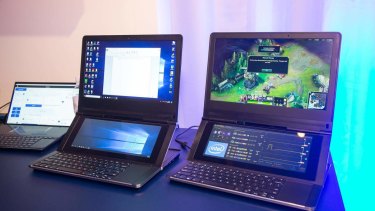After years of delay Intel has launched its first real batch of 10 nanometre CPUs at Computex in Taipei, claiming its new chips will spearhead the next evolution of laptops almost a decade after it helped usher in the era of thin-and-light notebook PCs with its “Ultrabook” initiative.
The company had a lot to prove going into the world's biggest computer hardware event. Its CPUs have been marred by a new class of Spectre-like security attacks and it faces strong competition on the desktop from a resurgent AMD, while mobile chipmaker Qualcomm continues to make inroads into its laptop business. But the new "Ice Lake" CPUs, set to arrive in new laptops later this year, headlined a strong showing.
The shift to 10nm refers to the transistor sizes on the CPU die; smaller transistors mean more of them can be packed onto a given area increasing performance as well as power efficiency. In terms of CPU performance, Ice Lake is faster but not a significant leap over the previous generation of processors. It has, however, received a huge boost in the integrated graphics department, making 1080p, reasonable frame rate gaming on modern titles like Destiny 2 a possibility on thin and light laptops.
The "Gen11" integrated graphics can also drive a 4K external monitor at 120Hz with 10-bit colour, or at 5K 60Hz.
Intel’s Ice Lake processors will be used as a launching pad for Project Athena; a multi-year program that charts a course for the PC ecosystem and should lead to a tangibly better laptop experience for consumers.
This is because for laptops to qualify for the Project Athena 1.0 spec, they must deliver in several key areas including performance, battery life, connectivity and form factor.
Project Athena laptops will need to hit nine hours of real-world battery life, meaning PC manufacturers won’t be able to fudge their battery life claims with video playback benchmarks that barely tax the processor. Instead, they must hit the 9 hour mark with Wi-Fi connected, Google Chrome with multiple tabs open, commonly used applications such as Microsoft Office running in the background and with a screen set to a brightness that a user might actually have in the real world. Charging times will receive a huge boost as well with project Athena laptops getting up to 4 hours of power within 30 minutes of charging.
Other Project Athena specs are about bringing the creature comforts of smartphones to PCs, and mirror some of the features seen on Qualcomm-powered Windows machines.
Laptops will need to wake from sleep in under a second and be ready to browse the web in under two seconds, download emails and grab social media updates in the background even while the lid is closed, and have the same sort of responsiveness on battery that they have when plugged into the wall.
The laptop display must support both touch and pen input with narrow bezels. Under the hood, the laptop must have at least 8GB of RAM and 256GB of speedy NVMe solid state storage and the latest Wi-Fi 6 and Thunderbolt 3 connectivity with the option for mobile connectivity.
At Computex, Intel gave us a first look at four laptops that meet Athena requirements, which include Dell’s XPS 13 2-in-1, the ultralight Acer Swift 5, HP’s Envy 13 Wood Series and Lenovo Yoga S940.
Intel will be ‘comprehensively’ testing and verifying every Project Athena laptop itself, saying the 1.0 Athena spec is the baseline that will deliver better and consistent experiences on the laptop for years to come.
Intel’s Honeycomb Glacier laptop prototypes.
Intel does more than just make chips of course. It also works with PC makers to create new form factors, and at this year's show it had some exciting dual-screen prototypes on display.
One, called "Honeycomb Glacier", features a built-in stand mechanism that lifts the primary 15.6-inch display to eye level and raises the secondary 12.3-inch display at an angle, for a two-screen experience similar to the Asus ZenBook Pro Duo but without the need to hunch over it. Built-in eye-tracking let's you shift your keyboard and mouse inputs between screens by simply looking at one or the other. Intel says that it is currently working with PC manufacturers to bring this dual-screen raised hinge form factor to market within the next year.
Another prototype called "Twin River" is designed to behave and be held like a book, with two 12.3-inch LCD screens wrapped in a polyester and lycra fabric material. Foldable PCs are set to hit the market next year but, according to Intel, two LCD screens will always be cheaper than a single foldable OLED. As such, it sees this setup as a more affordable option for those who want a foldable style PC experience without the premium price tag.
The author travelled to Taipei as a guest of Intel.
Source: Read Full Article
